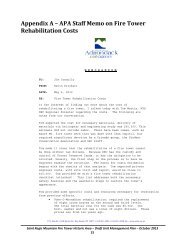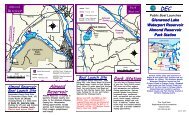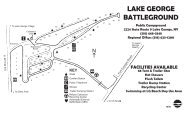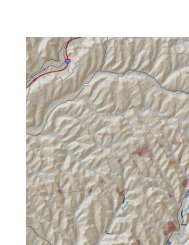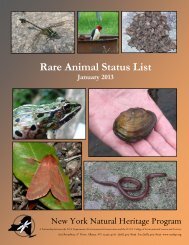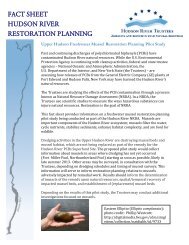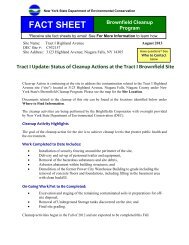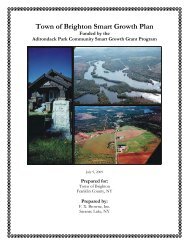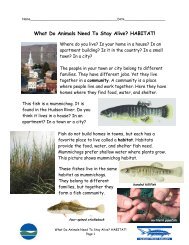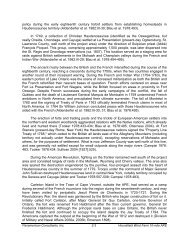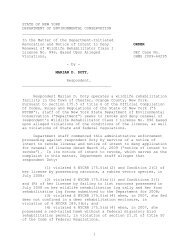Identifying NYS Waterfowl: Part 2- Conservationist Magazine
Identifying NYS Waterfowl: Part 2- Conservationist Magazine
Identifying NYS Waterfowl: Part 2- Conservationist Magazine
You also want an ePaper? Increase the reach of your titles
YUMPU automatically turns print PDFs into web optimized ePapers that Google loves.
A Sampler of New York’s <strong>Waterfowl</strong> Species<br />
Puddle Ducks<br />
Mallards are the most common duck year-round in<br />
NY, found in a wide variety of habitats, including urban<br />
park ponds. The drake has a metallic green head with a<br />
white neck ring,<br />
chestnut-colored<br />
chest,<br />
and white tail<br />
with black<br />
curled central<br />
tail feathers.<br />
Mike Anich<br />
The<br />
hen is a mottled brown color.<br />
The wings of both the drake and hen have<br />
a violet metallic speculum bordered by two<br />
white bars. Mallards usually fly in small<br />
flocks. Drakes make a low "kwek" or "yeeb"<br />
sound. The hens make the well-known loud quack.<br />
Black Ducks are similar in size to the mallard, but<br />
they are darker overall and at a distance look black. The<br />
drake and hen are identical with the head and neck a<br />
lighter brown. A<br />
dark streak<br />
runs through<br />
the eye from<br />
the bill<br />
across the<br />
cheek. The<br />
underside of<br />
their wings are<br />
white and the<br />
contrast between<br />
the white on the<br />
wings and dark<br />
body is a good identification<br />
clue when seeing the birds in flight. Black duck<br />
wings have a violet-blue speculum and lack the two<br />
white bars present on the mallard's wings. Adults make<br />
sounds similar to mallards.<br />
Wood Ducks have a crested head, broad wings and<br />
rectangular tail. The drake is beautifully colored with an<br />
iridescent green<br />
Eric Dresser and purple<br />
head, back,<br />
wings and<br />
tail. The<br />
drake's crest<br />
is much<br />
more pronounced<br />
than<br />
the hen's. The hen is dark brown with tan and grey<br />
sides and has a white teardrop-shaped ring around her<br />
eye. Drakes make a loud "whoo-wett" sound when distressed<br />
and a high-pitched whistle in courtship. Hens<br />
make a squeeling "crrek-crrek" sound.<br />
Blue-Winged Teal are easy to identify by their small<br />
size and erratic flight. Both drakes and hens have slateblue<br />
wing patches and a green speculum. Drakes<br />
have a white crescent on each side of their<br />
Edward Jakubowski<br />
face. The hen lacks<br />
the facial crescent<br />
and is a mottled<br />
brown color. Drakes<br />
make whistling<br />
"peep" sounds. Hens<br />
make a faint quack.<br />
Green-Winged Teal are small pigeon-sized ducks.<br />
Both drakes and hens have a green speculum. The drake<br />
has a rusty-colored<br />
head and a bright<br />
green slash across<br />
the eye. A white<br />
vertical bar separates<br />
the buff-colored<br />
chest from<br />
the grey<br />
back<br />
and sides.<br />
The hen is<br />
a mottled<br />
brown color.<br />
Drakes make<br />
Deanne C. Cunningham<br />
short whistle and peeping sounds. Hens make a<br />
high-pitched quack.<br />
Pintails (Sprig ) are large, mallard-sized ducks and<br />
can be easily identified by their long, pointed tail feathers<br />
and long, slender profile in flight. The drake<br />
has a chocolate brown head with a<br />
white stripe running up both<br />
sides of its neck. His throat,<br />
chest and belly are white. The<br />
hen's long, slender shape is<br />
not as distinct as the drake's, but she
still has a longer tail than most ducks. The hen is a mottled<br />
brown color. Drakes make a double tone "prrip,<br />
prrip" whistle. Hens<br />
make low quacks.<br />
Diving Ducks<br />
Scaup (bluebill, broadbill) are often seen in<br />
large groups (called rafts) on large bodies of water.<br />
Both drakes and hens have a blue-grey bill with a black<br />
tip and have a broad white stripe on the trailing edge<br />
of the wing.<br />
The Lesser Scaup is the<br />
most common species of<br />
diving duck. The drake's<br />
head has a purplish-black<br />
sheen and often appears<br />
angular. The drake's<br />
neck, head,<br />
chest and<br />
rump are<br />
black and the<br />
sides and undersides<br />
are pale grey to<br />
white. The hen is dark<br />
brown with whitish undersides.<br />
She has a distinctive<br />
white patch at the base of her<br />
bill. The wings of both the drake and the hen are charcoal<br />
brown with a long white patch or stripe running<br />
down the trailing edge of the wing. Drakes make a low,<br />
single note whistle or a loud quack. Hens make purring<br />
or low growling sounds.<br />
Greater Scaup are slightly larger than the lesser<br />
scaup and are very<br />
similar in appearance.<br />
The drake's<br />
head has a greenish-black<br />
sheen<br />
and is more<br />
rounded in shape.<br />
The wings are<br />
similar to the lesser<br />
scaup's, but the coloration is more brown<br />
and the white wing patch or stripe is longer. Drakes<br />
make a "scaup, scaup" sound. Hens are usually silent.<br />
The Canvasback is the fastest flying duck. It is easily<br />
identified by its "doorstop" shaped head. The drake's<br />
head is red with a<br />
long, black bill. It has a greyish-white<br />
back and sides. The hen is buff-colored<br />
with a rusty-brown head and chest, and<br />
dusky-grey back. Canvasbacks usually shift from waving<br />
lines to temporary V's in flight. Drakes make a low<br />
croak, peep and even growl. Hens quack.<br />
The Redhead has a more rounded head and shorter<br />
bill than the canvasback.<br />
The drake has<br />
a reddish head, but<br />
is slightly<br />
smaller and has a darker back and<br />
sides. The bill is blue-grey with a narrow<br />
white ring located behind the<br />
black tip. The hen has a reddishbrown<br />
head and breast with drab<br />
brown back and sides. Drakes "purr" and make a catlike<br />
"meow" sound. Hens make a high, loud "squak" and a<br />
soft growling sound.<br />
The Common<br />
Goldeneye<br />
(Whistler ) is named for<br />
its gold-colored eye. The<br />
drake’s<br />
head is<br />
black<br />
with a<br />
greenish<br />
sheen and has a white round spot in front<br />
of the eye. A row of black and white<br />
feathers separate the black back and rump<br />
from the white chest and undersides. The<br />
hen's head is dark brown with no facial spot. Her sides<br />
and back are greyish-brown with a white chest. The<br />
wings of the common goldeneye whistle in flight.<br />
Drakes make a nasal double-note "pee-ik" sound. Hens<br />
make a low quack.
The Bufflehead (Butterball) is a very small duck<br />
with a rounded shape. The drake's head is black with a<br />
greenish-purple<br />
sheen and has a<br />
white<br />
wedgeshaped<br />
Edward Jakubowski<br />
patch behind the<br />
eye. The hen's head is dark brown with a small white<br />
patch behind the eye. Her back is dark brown with greyish<br />
sides and a white belly. They are usually silent, but<br />
drakes make a hoarse "squeek" sound and hens make a<br />
harsh quack.<br />
Mergansers are streamlined-shaped ducks with long<br />
pointed bills with saw-edge mandibles used for grasping<br />
fish. They are often seen on rivers and large streams.<br />
Mergansers usually fly in a single straight line close to<br />
the water.<br />
The Common Merganser drake<br />
has a dark green head with no<br />
crest, a black back<br />
and white<br />
sides and belly.<br />
The hen has a<br />
Edward Jakubowski<br />
brown crested<br />
head. Her back, chest and sides are grey and her belly<br />
is white. Drakes make low "croak" sounds and hens<br />
make a harsh, gutteral sound.<br />
The Red-Breasted Merganser drake has a crested<br />
green head, a reddish-brown chest, a<br />
black back and a<br />
white belly. The<br />
hen has a less<br />
pronounced crest<br />
and reddishbrown<br />
head. They<br />
are usually silent,<br />
but make a<br />
hoarse "croak" sound.<br />
These birds are primarily<br />
seen on coastal<br />
waters in winter.<br />
The Hooded Merganser is the smallest of the<br />
mergansers. The drake has a pronounced<br />
fan-shaped, black and white<br />
crest. His back is black with white<br />
stripes with brownish<br />
sides. The hen<br />
has a reddishbrown<br />
crested<br />
head and dark<br />
back. They make<br />
low grunting or<br />
croaking sounds.<br />
Edward Jakubowski<br />
Scoters are sea ducks commonly seen in coastal<br />
waters and around the Great Lakes.<br />
The White-Winged Scoter (Sea coot)<br />
is the most numerous of the scoters in <strong>NYS</strong>.<br />
The drake is all black except the<br />
white wing patch and the small<br />
white crescent around the eye. His<br />
orange-yellow bill is knobbed<br />
and has a reddish tip. The<br />
hen is slightly lighter in color<br />
and has a smaller white<br />
speculum. She has tancolored<br />
cheek patches<br />
and a greyish bill with no<br />
knob. They fly in a stringy<br />
line or V-formation, and<br />
make bell-like whistle<br />
sounds.<br />
Geese and Swans<br />
Canada Geese are probably<br />
the most easily recognized<br />
waterfowl in <strong>NYS</strong>. Their<br />
large size, black neck and<br />
head with white cheek<br />
patches extending under the<br />
throat, and brownish-grey<br />
body make them easy to<br />
identify. They fly in long strings in V-formation. Canada<br />
geese make a loud, deep "honking" sound.<br />
Edward Jakubowski<br />
Most Adult Snow Geese have an all white body and<br />
black wing tips. Young often have an ashy-gray appearance,<br />
and some adults, called “blue geese,” have very<br />
dark bodies with just a white head. Snow geese have a<br />
shorter neck than swans.<br />
Very noisy birds, their call is<br />
a shrill honk, higher-pitched<br />
than the Canada goose.
The Tundra Swan (Whistling ) has an all<br />
white body, black feet, and a small yellow spot<br />
at the base of its black bill. Tundra Swans make<br />
highpitched<br />
cooing<br />
sounds.<br />
Edward Jakubowski<br />
Donna Aitkenhead<br />
The Trumpeter Swan is slightly<br />
larger than the Tundra Swan and has an<br />
all black bill. Its name comes from the<br />
bird’s distinctive loud, brassy voice. The<br />
first pair of recently-recorded nesting<br />
trumpeter swans in <strong>NYS</strong> was found in<br />
1996.<br />
Snow<br />
Goose<br />
(white<br />
phase)<br />
General Characteristics of Puddle and Diving Ducks<br />
Puddle<br />
Ducks<br />
shallow marshes<br />
and rivers<br />
colored, irides-<br />
Eric Dresser<br />
cent wing patch<br />
legs near middle of body, walks well on land<br />
feeds on or just below water surface by<br />
tipping or dabbling<br />
most feed primarily on aquatic vegetation<br />
sits high with tail out of water<br />
larger wings, slower wingbeat<br />
can take right off and fly from water<br />
The Mute Swan is probably<br />
the most familiar swan in <strong>NYS</strong><br />
with its S-shaped curved neck. It<br />
was an import to North America<br />
from Europe, but has established<br />
breeding populations. Adults<br />
have an orange bill with a black<br />
knob on the forehead, and black<br />
feet. They will make grunting or<br />
wheezing noises.<br />
Canada Goose<br />
Tundra Swan<br />
Mute Swan<br />
John Huggard<br />
Trumpeter Swan<br />
Snow Goose (blue phase)<br />
Diving<br />
Ducks<br />
large lakes,<br />
rivers, bays<br />
white, grey,<br />
and black wing<br />
patch<br />
legs farther back on body, prefers to stay<br />
in water<br />
dives beneath the surface to feed<br />
most feed on fish and invertebrates<br />
sits lower with tail close to water<br />
smaller wings, shorter, faster wingbeat<br />
runs on water to gain speed for take-off
Puddle ducks (9)<br />
___ mallard<br />
___ black duck<br />
___ wood duck<br />
___ pintail<br />
___ blue-winged teal<br />
___ green-winged teal<br />
___ American wigeon<br />
___ shoveler<br />
___ gadwall<br />
Mergansers (3)<br />
___ hooded<br />
___ red-breasted<br />
___ common<br />
1999 Migratory Bird Print and Stamp<br />
"Hudson River Heritage" by Richard Clifton<br />
New York Migratory Bird Print<br />
and Stamp Program<br />
In 1985, New York developed the Migratory Bird Print<br />
and Stamp Program, a revenue generating program to<br />
address the rapid decline in wetland habitat triggered by<br />
changes in land use practices. Through the sale of collector<br />
prints, posters, pins and stamps, more than $2.5<br />
million has been generated to acquire and manage wetlands<br />
in New York and Canada. Preservation of these<br />
habitats provides many waterfowl species with<br />
improved nesting, feeding and resting areas, while also<br />
enhancing opportunities for wildlife photography and<br />
observation.<br />
For further information regarding the program<br />
visit our website at<br />
www.dec.state.ny.us/website/dfwmr/wildlife/migrbird/index<br />
.html or call 1-800-325-2370.<br />
<strong>NYS</strong> <strong>Waterfowl</strong> Checklist<br />
Geese and Swans (6)<br />
___ Canada goose<br />
___ brant<br />
___ snow goose<br />
___ tundra swan<br />
___ mute swan<br />
___ trumpeter swan<br />
Divers (8)<br />
___ canvasback<br />
___ redhead<br />
___ ring-necked duck<br />
___ greater scaup<br />
___ lesser scaup<br />
___ common goldeneye<br />
___ ruddy duck<br />
___ bufflehead<br />
Artwork by Jean Gawalt, text by Cheryl O’Brien<br />
Sea Ducks (7)<br />
___ white-winged scoter<br />
___ surf scoter<br />
___ black scoter<br />
___ common eider<br />
___ king eider<br />
___ oldsquaw<br />
___ harlequin duck<br />
<strong>Waterfowl</strong> Identification Course<br />
Included in DEC <strong>Waterfowl</strong> Hunter<br />
Education Course<br />
The DEC waterfowl hunter education course is a great<br />
course for both hunters and non-hunters alike because<br />
it includes a complete course in waterfowl identification.<br />
The three-hour (minimum) course teaches you about<br />
waterfowl life history, habits, and key features to look for<br />
to identify birds in the field, in addition to other information<br />
that hunters will find helpful.<br />
Upon successful completion of the course, participants<br />
receive a DEC certificate of completion. The<br />
course is not required for hunting waterfowl in general.<br />
However, a few public waterfowl hunting areas that have<br />
limited access require hunters to pass a waterfowl identification<br />
course, or may give preference to those with<br />
course certificates. State and federal agencies with such<br />
limitations let hunters know about this when they apply<br />
for area hunting permits.<br />
For information about courses, contact the Sportsman<br />
Education Coordinator at your DEC Regional Office, or<br />
the Sportsman Education Program at 50 Wolf Road,<br />
Albany, N.Y. 12233-4800, or call 1-888-HUNT ED2.<br />
Course listings are also available on DEC's website at<br />
www.dec.state.ny.us/website/dfwmr/edhunt.htm



